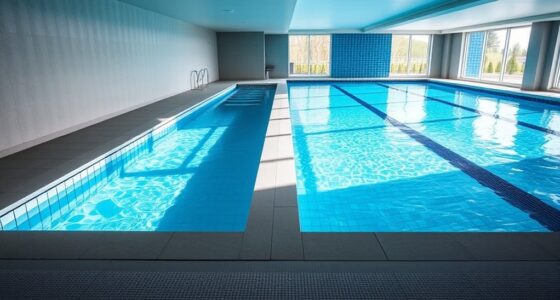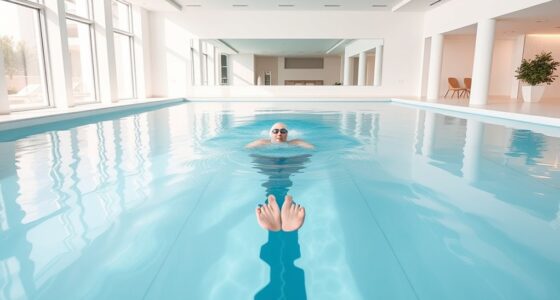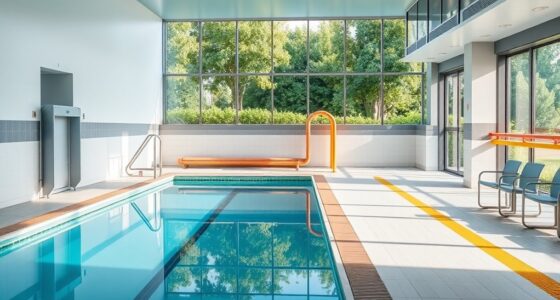To keep kids safe and entertained in an endless pool, choose one with safety features suited to their age, like adjustable flow speeds and non-slip surfaces. Supervise always with a focused adult, using safety equipment like alarms and barriers. Plan fun, age-appropriate activities and teach essential water skills to build confidence. Stay prepared for emergencies and maintain a clean environment. Keep exploring for more tips to ensure your child’s swimming experience is safe and enjoyable.
Key Takeaways
- Choose a pool with safety features, appropriate size, and adjustable flow speeds for children’s age and swimming skills.
- Maintain water quality regularly and ensure emergency plans, CPR skills, and supervision protocols are in place.
- Use constant, attentive supervision, designated zones, and safety equipment like alarms, barriers, and rescue gear.
- Offer age-appropriate water activities and games to build skills, confidence, and promote safe, fun experiences.
- Conduct regular safety drills, keep environment hazard-free, and encourage creative water play for developmental benefits.
Choosing the Right Endless Pool for Kids
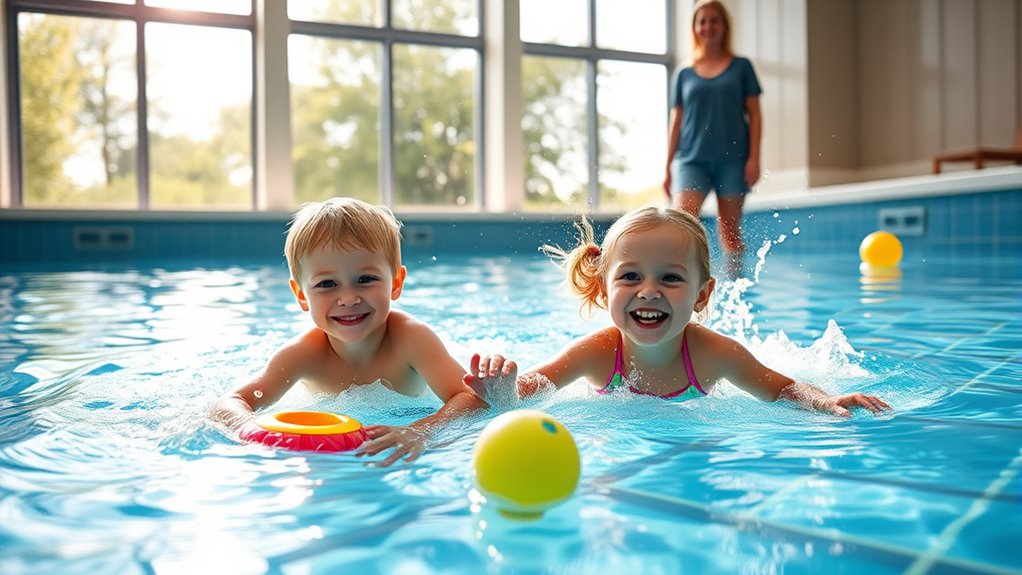
When selecting an endless pool for kids, it’s essential to prioritize safety features and size to guarantee a suitable fit for your child’s age and swimming ability. Start by evaluating the pool’s dimensions; younger children need smaller, more manageable spaces, while older kids can handle larger pools. Look for adjustable flow speeds to match your child’s skill level, ensuring they can build confidence without feeling overwhelmed. Consider the pool’s overall depth and width, making sure there’s enough room for safe movement and practice. A non-slip surface and sturdy construction are vital for preventing accidents. Remember, choosing a pool that fits your child’s current abilities encourages safe play and growth, so take the time to select a model that adapts as they improve. Additionally, understanding the importance of proper supervision is key to ensuring a safe swimming environment for children in an endless pool.
Essential Safety Features and Equipment
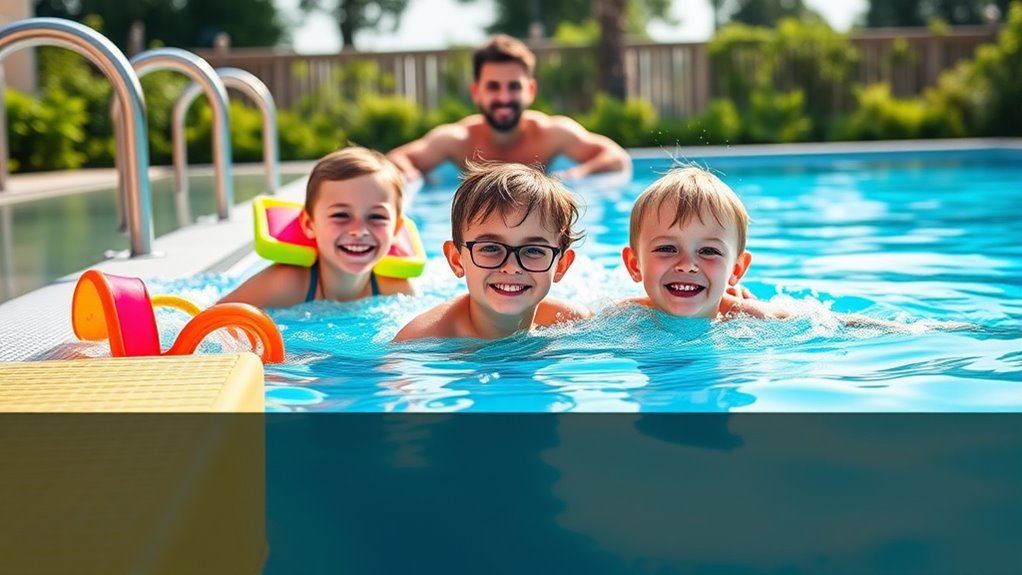
Ensuring your child’s safety in an endless pool depends heavily on selecting the right safety features and equipment. Start with a sturdy, lockable cover that keeps children from accessing the water unsupervised. Install a reliable pool alarm that alerts you if someone enters unexpectedly. Consider a safety rope or barrier to create a designated shallow area, reducing risks for younger swimmers. Anti-slip surfaces around the pool prevent falls, especially when the area is wet. Keep rescue equipment, like a reaching pole or life hook, nearby and easily accessible. Make sure you have a fully stocked first aid kit ready for emergencies. Additionally, integrating AI-powered safety systems can enhance monitoring and provide real-time alerts to prevent accidents. These safety features and equipment create a secure environment, giving you peace of mind as your kids enjoy the pool responsibly.
Supervision Strategies for Young Swimmers

Supervision is the cornerstone of keeping young swimmers safe in an endless pool. Always stay within arm’s reach when kids are in the water. Assign a dedicated adult to watch continuously, avoiding distractions like phones or reading. Establish clear rules, such as no running or roughhousing, and enforce them consistently. Use visual cues, like designated swimming zones, to help children stay safe. Consider implementing a buddy system so children look out for each other. Regularly rotate supervision to prevent fatigue. Here’s a quick reference:
| Supervision Strategy | Action | Purpose |
|---|---|---|
| Constant Attentiveness | Keep eyes on children at all times | Immediate response to emergencies |
| Clear Rules | Set and enforce safety guidelines | Minimize risky behavior |
| Designated Zones | Mark swimming areas clearly | Prevent wandering or accidents |
Additionally, understanding supervision strategies can enhance safety protocols and ensure a secure environment for young swimmers.
Age-Appropriate Water Activities and Games
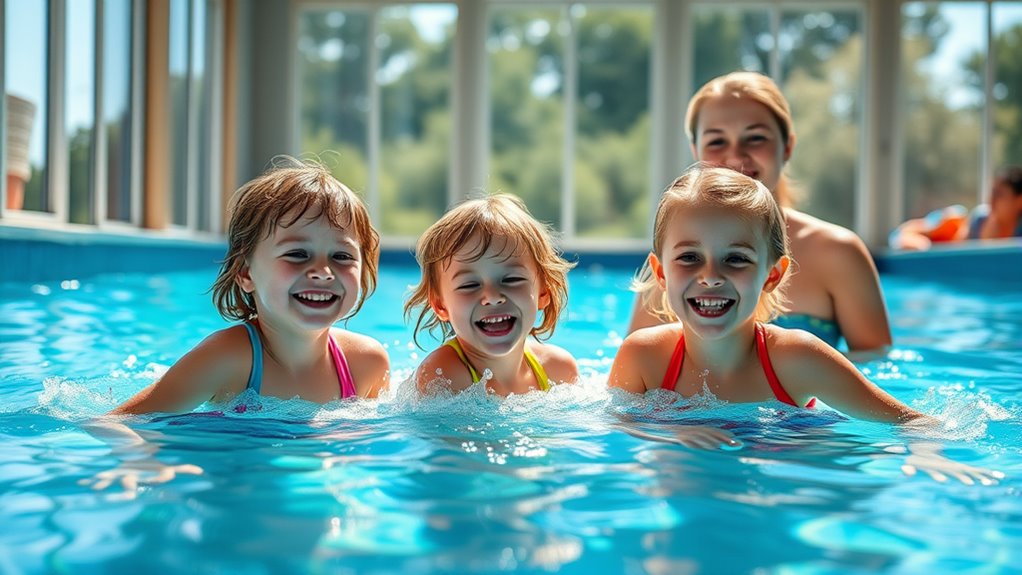
You can make water activities safe and fun by selecting age-appropriate games for every child. For toddlers, simple water play helps build comfort, while teens might enjoy challenging water games that test their skills. Choosing the right activities keeps everyone engaged and safe in your Endless Pool. Incorporating animated movies that touch hearts can also provide relaxing entertainment for family members during poolside downtime.
Toddler Water Play
Introducing age-appropriate water activities helps toddlers develop confidence and coordination while having fun. Simple games like splash contests or pouring water between containers teach them about water movement and control. Encourage gentle floating on their backs or stomachs with supervision, helping build comfort in the water. Using waterproof toys, such as rubber ducks or floating rings, keeps them engaged and motivated to explore. Keep activities short—around 10 to 15 minutes—and always stay within arm’s reach. Incorporate songs or playful cues to make the experience enjoyable. Remember, the goal is to foster a positive attitude toward water while ensuring safety. By creating a fun, supportive environment, you help your toddler build essential water skills with confidence. Additionally, understanding the role of water safety can further enhance your supervision strategies and ensure a secure environment for your little one.
Teen Water Challenges
As teens seek engaging ways to enjoy the water, age-appropriate challenges can boost their skills and confidence while keeping the fun alive. You can introduce water-based activities like synchronized swimming routines or relay races that encourage teamwork and improve coordination. Water obstacle courses or floating obstacle challenges test their agility and problem-solving skills, making the experience exciting and rewarding. Incorporate games like water volleyball or basketball to promote friendly competition and social interaction. Remember to set clear boundaries and supervise closely to guarantee safety while allowing teens to push their limits. These activities not only enhance their water competence but also foster independence and resilience. Leveraging AI security in safety monitoring can provide real-time alerts and enhance supervision accuracy. Keep challenges fun, safe, and tailored to their skill levels for the best experience.
Teaching Kids Basic Water Skills and Confidence

Teaching kids basic water skills and building their confidence are essential steps toward ensuring they enjoy swimming safely. Start with simple tasks like blowing bubbles, kicking, and floating to help them feel comfortable in the water. Demonstrate proper techniques and encourage repeated practice in a positive, patient manner. Use fun activities and praise their efforts to boost confidence. Focus on teaching essential skills such as safe entering and exiting, how to hold their breath, and basic strokes. Remember, consistency is key; practicing regularly helps kids gain familiarity and trust in their abilities. Keep sessions short and engaging to prevent frustration. As they progress, they’ll become more confident, making water activities enjoyable and safe for them. Incorporating structured practice routines can also help children develop their skills more effectively.
Establishing Rules and Boundaries in the Pool
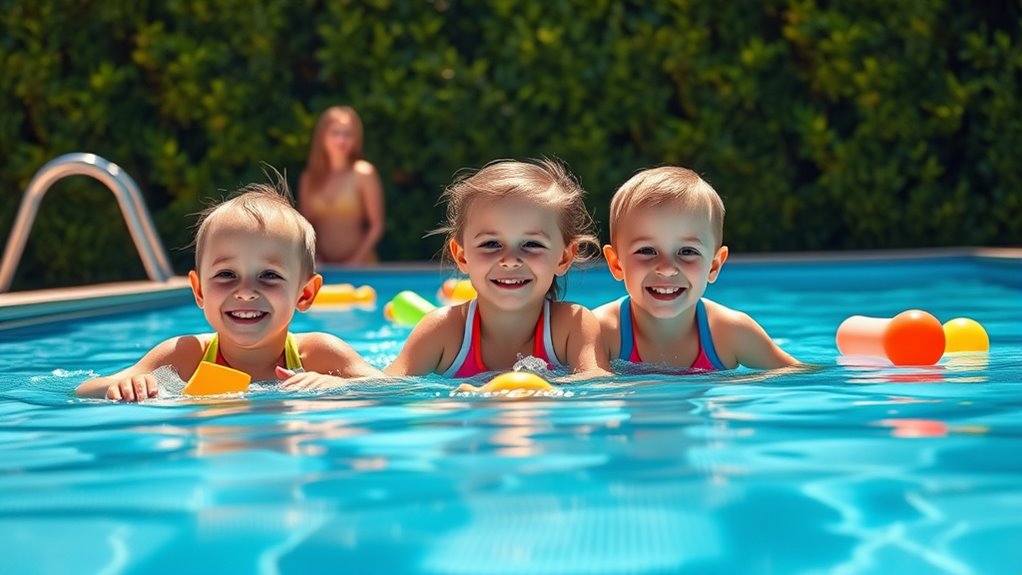
Establishing clear rules and boundaries is essential for keeping kids safe and confident in the pool. Start by explaining these rules calmly and consistently, making sure your kids understand what’s expected. Set boundaries around areas where they can play, and define limits on behaviors like running or roughhousing. Use visual cues such as flags or signs if needed, and reinforce these rules regularly. Always supervise your kids closely, especially when they’re near the water, and remind them that rules are in place to keep everyone safe. Be firm but patient, and encourage your kids to ask questions if they’re unsure about anything. Consistent boundaries help kids feel secure and understand how to enjoy the pool responsibly. Recognizing signs of discomfort or distress can also help you intervene promptly and ensure their safety at all times.
Emergency Preparedness and Safety Protocols
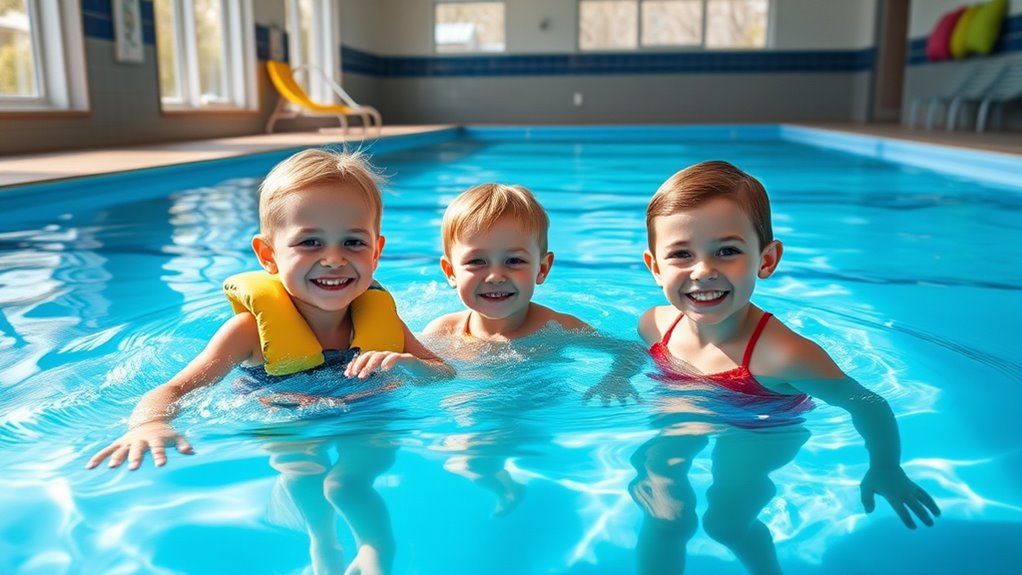
Being prepared for emergencies is crucial to ensuring your kids’ safety in the pool. You should have a clear emergency plan in place, including how to quickly reach emergency services. Keep a phone nearby at all times, and make sure everyone knows how to use it. Learn CPR and first aid so you can respond instantly if needed. Designate a responsible adult to supervise at all times, even when kids are experienced swimmers. Keep safety equipment like life rings and reaching poles accessible and in good condition. Practice emergency drills regularly with your children, so they know what to do if something goes wrong. Staying alert and ready helps you react swiftly, reducing risks and ensuring everyone’s safety in any situation. Additionally, understanding the history of pinball machines can help you recognize potential distractions or hazards that could occur in environments where pinball machines are present.
Maintaining a Clean and Safe Pool Environment
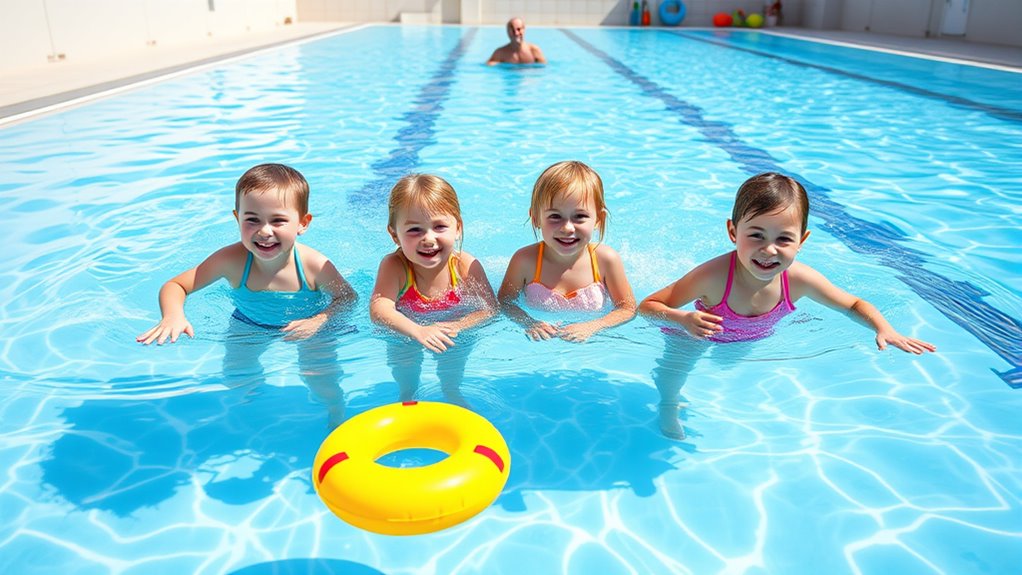
Keeping the pool environment clean and safe is a vital part of safeguarding your kids while they swim. Regularly check and clean the pool filters to prevent debris buildup, which can affect water quality. Test the water’s pH and chlorine levels weekly to keep the water balanced and free of harmful bacteria. Always remove leaves, bugs, and dirt from the surface before children enter the pool. Encourage everyone to shower before swimming to reduce contaminants. Keep a safe supply of pool chemicals out of children’s reach, and follow manufacturer instructions for proper use. Regularly inspect the pool area for hazards like loose tiles or sharp objects. Utilizing essential oils with antimicrobial properties can help maintain a healthier environment around the pool area. A well-maintained pool not only guarantees cleaner water but also minimizes risks, creating a safer environment for your kids to enjoy.
Creative Ideas for Pool-Based Play and Learning
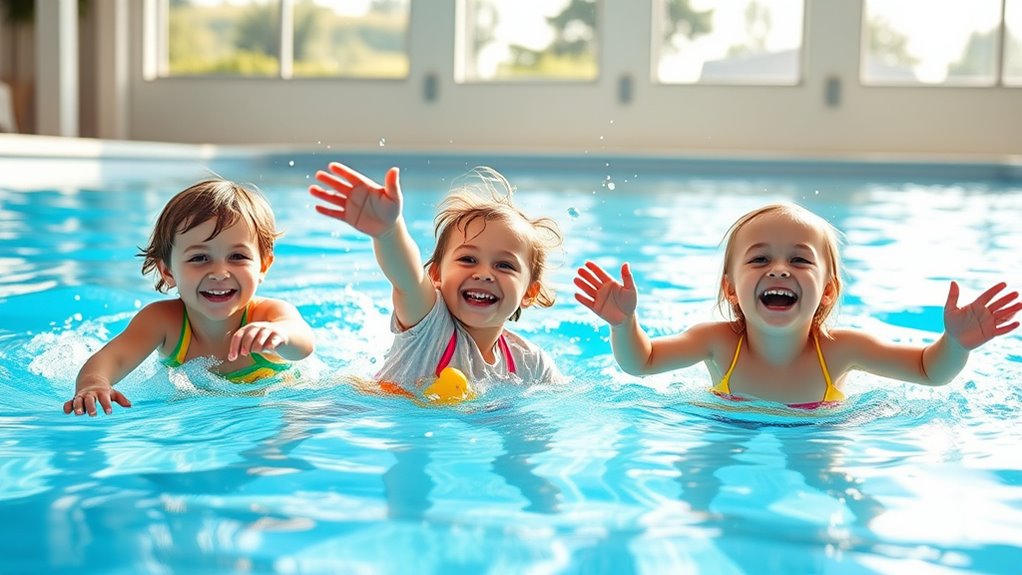
Transforming your pool into a space for creativity and learning can turn ordinary swim sessions into engaging experiences. You can introduce simple games like treasure hunts, where kids search for submerged objects, or relay races that build coordination and teamwork. Incorporate floating puzzles or foam shapes to encourage problem-solving and shape recognition. Set up water-based art projects, such as washable waterproof chalk or color-changing tablets, to inspire artistic expression. Use pool noodles and inflatable toys for obstacle courses that promote balance and agility. Incorporate educational themes, like counting or alphabet games, to make learning fun and active. These ideas not only keep kids entertained but also stimulate their minds, making every swim session an opportunity for playful discovery and skill-building.
Benefits of Supervised Pool Time for Children’s Development
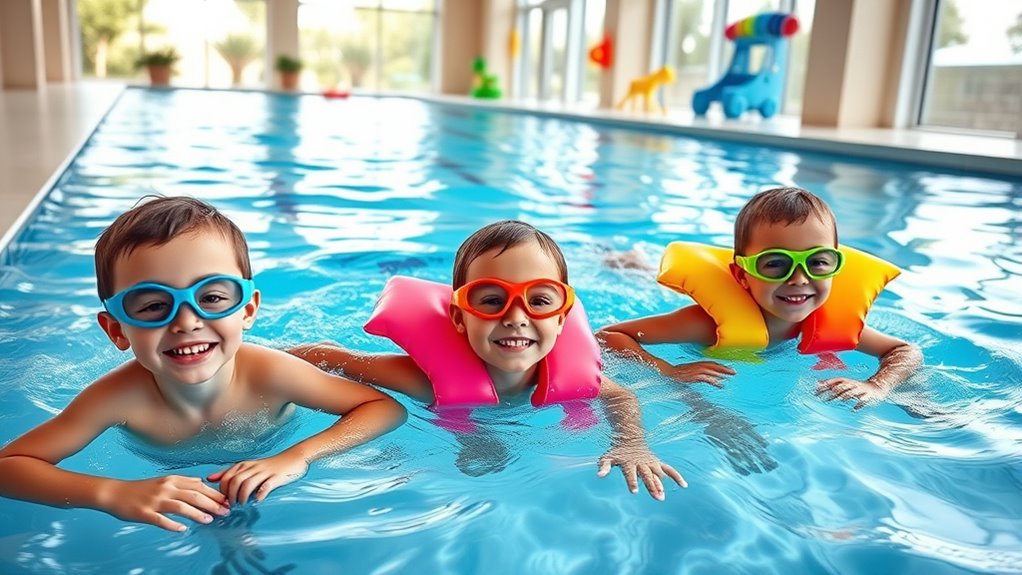
Supervised pool time plays a crucial role in supporting children’s physical, social, and emotional development. When you supervise, you help children build confidence in their swimming skills and promote physical activity, which strengthens muscles and improves coordination. It also encourages social interaction as kids learn to take turns, share, and communicate with peers during pool games. Emotionally, supervision provides a sense of security, helping children feel safe while exploring water activities. It teaches responsibility and respect for pool safety rules, instilling lifelong habits. By staying attentive, you can quickly address potential hazards and prevent accidents. Overall, supervised pool time creates a positive environment where children develop essential skills, confidence, and safety awareness—all while having fun in the water.
Frequently Asked Questions
How Can Parents Ensure Kids Stay Safe During Spontaneous Pool Play?
To keep kids safe during spontaneous pool play, always supervise them closely, even if they’re experienced swimmers. Set clear rules about boundaries and safe behavior, and guarantee they stay within your sight. Use floatation devices when necessary, and teach them to avoid risky actions like diving or roughhousing. Keep emergency equipment nearby, and educate them on what to do if they get into trouble. Your vigilance is key to preventing accidents.
What Signs Indicate a Child Is Ready for Independent Pool Activities?
You’ll know your child is ready for independent pool activities when they consistently demonstrate strong swimming skills, understand pool safety rules, and can stay calm in the water. They should also show responsibility, follow instructions, and avoid risky behaviors. Make sure they’ve had plenty of supervised practice first, and always check their confidence level. When they handle these responsibilities well, it’s a good sign they’re ready for some independence in the pool.
Are There Specific Water Temperature Guidelines for Kids in an Endless Pool?
Yes, there are specific water temperature guidelines for kids in an endless pool. Keep the water between 84°F and 89°F to guarantee comfort and safety. Temperatures above 89°F can cause overheating, while below 84°F may be too cold for young children. Always monitor your child’s reactions and adjust the temperature as needed. Remember, proper supervision and frequent breaks are essential for their safety and enjoyment.
How Often Should Pool Safety Equipment Be Inspected and Maintained?
You should inspect and maintain your pool safety equipment monthly to guarantee it’s in good condition. Regular checks include testing life jackets, inspecting rescue devices, and verifying alarms are functioning properly. After each use or if you notice any damage, perform immediate maintenance or replacements. Proper upkeep not only keeps kids safe but also ensures quick, effective responses during emergencies. Staying diligent helps prevent accidents and maintains a safe swimming environment.
What Are Effective Ways to Keep Children Engaged Without Overexposing Them to Water?
Think of keeping kids engaged as planting seeds of curiosity. You can introduce water-based crafts, like watercolor painting or floating boat races, to spark their interest without constant water exposure. Incorporate dry land activities such as obstacle courses or nature scavenger hunts to balance their energy. By mixing water fun with land adventures, you create a playground where their excitement blooms, all while keeping water interactions safe and enjoyable.
Conclusion
Just like Icarus trusted the sun, trust your judgment and supervision to keep your kids safe and confident in the endless pool. With the right choices, safety measures, and creative play, you’re nurturing their growth and joy—building a foundation as timeless as childhood itself. Remember, your vigilant guidance transforms pool time from a fleeting moment into a lifelong memory, proving that safety and fun can indeed swim together seamlessly.



